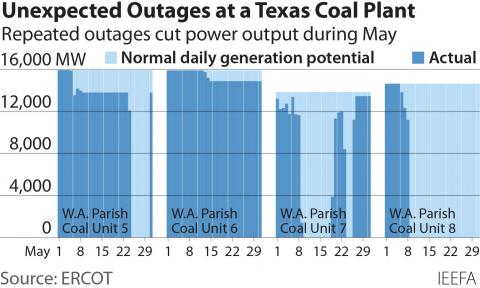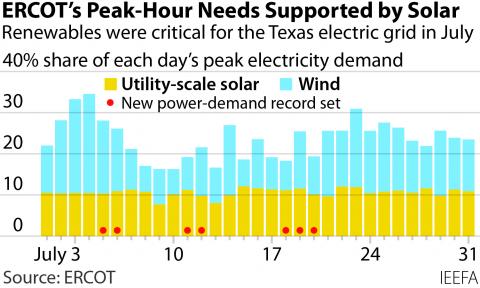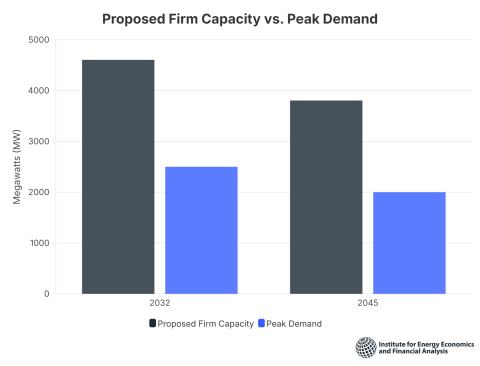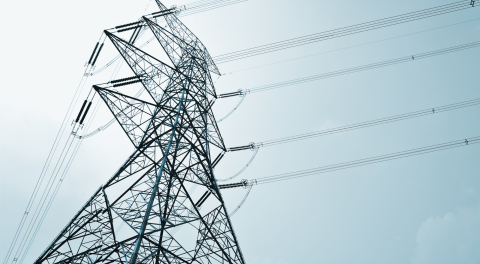
Key Findings
More than 100,000 megawatts of coal- and gas-fired generation failed to start or were forced offline during the Arctic blast that hit the central and eastern U.S. just before Christmas.
December outages stressed utilities across the Eastern Interconnection and forced unprecedented rolling blackouts at two major utilities.
Highly accurate forecasting, together with the rapid growth of battery storage, can help to smooth the gaps in wind and solar variability to prevent future outages.
The problems encountered across the central and eastern U.S. during Winter Storm Elliott show that it is time for a more honest discussion about the reliability of the nation’s fossil fuel-fired electric generation resources.
Executive Summary
Coal- and gas-fired electric generators are not nearly as reliable as their proponents claim. During the peak of an Arctic blast in the central and eastern U.S. on Dec. 23-24, more than 100,000 megawatts (MW) of coal- and gas-fired generation were offline due to the cold associated with Winter Storm Elliott, highlighting serious performance problems for fossil fuel generators. The outages stressed the entire Eastern Interconnection of the U.S. electricity system and prompted first-of-a-kind rolling blackouts by the Tennessee Valley Authority (TVA) and Duke Energy. In PJM, the nation’s largest electricity market, the failure to honor reliability commitments may cost coal and gas plant owners as much as $2 billion in penalties.
This report examines the problems that surfaced during the freeze, paying particular attention to the unreliability exhibited by coal and gas generators in five hard-hit areas: the Electric Reliability Council of Texas (ERCOT), the operator of the grid supplying 90 percent of the electricity in Texas; the Midcontinent Independent System Operator (MISO) which serves 15 states as well as the Canadian province of Manitoba; PJM, which supplies power from New Jersey to Illinois; TVA, which serves 10 million people in its seven-state territory; and Duke Energy’s North Carolina service territory, served by Duke Energy Carolinas and Duke Energy Progress.
Fossil fuel generation outages occurred everywhere. In PJM, more than 32,500MW of gas and 7,600MW of coal capacity were offline at the height of the cold, despite the substantial capacity payments PJM pays generators to be available at critical times. MISO, which has significantly less total installed generation than PJM, fared almost as poorly. A total of 37,000MW of its coal and gas capacity were offline at the peak. In ERCOT, more than 14,000MW of thermal resources were offline during the storm’s peak, even though the state directed generators to better winterize their generation plants in the wake of Winter Storm Uri in 2021. The two individual utilities also reported significant problems. TVA counted roughly 8,000MW of coal and gas that were offline during the height of the event, including its largest coal plant, the 2,470MW Cumberland facility. Duke said almost 4,000MW of its fossil generation were unavailable when needed.
The scope of the problems prompted the Federal Energy Regulatory Commission (FERC) and the North American Electric Reliability Corporation (NERC), the organization responsible for overall grid safety and reliability, to launch a joint inquiry into the events surrounding the December freeze and the performance of the nation’s bulk power system. While that review is just starting, FERC approved two winter reliability standards in February that had been proposed by NERC in the wake of the 2021 storm.
The new standards, FERC said, include “generator freeze protection measures, enhanced cold weather preparedness plans, identification of freeze-sensitive equipment in generators, corrective actions for when equipment freeze issues occur, annual training for generator maintenance and operations personnel, and procedures to improve the coordination of load reduction measures during a grid emergency.”
Even as it adopted these post-2021 standards, however, FERC also directed NERC to come back to the commission with better winter reliability standards, clearly a recognition that there are still gaps. The concerns were underscored by Commissioner Allison Clements: “There are good measures in these standards, but the requirements for generators to winterize are, to be frank, not up to the severity and gravity of the problems we’re facing. We must do better.”
Clearly, it is time for a different conversation regarding fossil fuel generation’s reliability, particularly in cold weather.
Gas- and coal-fired power plants can be reliable, but simply assuming they will be available and dispatchable because they are gas- and coal-fueled is no longer a tenable proposition, although that remains a prevalent belief. In a Tennessee House of Representatives hearing examining the problems at TVA, Greg Henrich, a utility vice president, told legislators that when it calculates its reserves, “we assume all of our [thermal] plants are capable of 100% output.” Similarly, in its winter capacity assessment, ERCOT said 94% of its thermal generating resources would be available. The optimistic fossil forecasts were egregiously incorrect, and the widespread and repeated outages show it is time for a more accurate assessment of thermal reliability.
Fossil fuel proponents have long derided wind and solar generation as resources that cannot be relied upon to deliver power on an as-needed basis. But highly accurate forecasting, together with the rapid growth of battery storage, has already significantly undercut criticism, helping to smooth the gaps in wind and solar’s predictable variability. And now, with fossil fuel generation proving increasingly unreliable at critical times, it is time for an honest reassessment of how to operate the nation’s electric grid reliably.
















